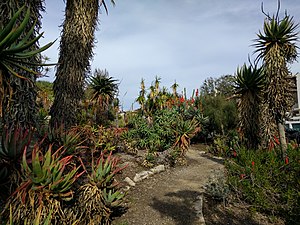Mildred E. Mathias Botanical Garden
| Mildred E. Mathias Botanical Garden | |
|---|---|
 Aloes at the garden | |
| Type | Public |
| Location | Los Angeles, California, United States |
| Nearest city | Los Angeles |
| Coordinates | 34°03′57″N 118°26′28″W / 34.065788°N 118.441157°W |
| Area | 7 acres (2.8 ha) |
| Created | 1906 by Mildred Esther Mathias Hassler |
| Status | Open year round |
| Website | The Mildred E. Mathias Botanical Garden |
The Mildred E. Mathias Botanical Garden is a 7-acre (2.8 ha) botanical garden located on the southeastern corner of the University of California, Los Angeles (UCLA) campus, California, United States. It is named after Mildred Esther Mathias Hassler (1906–1995), a noted American botanist. The director is Victoria Sork.
History
UCLA's botanical garden was started as an academic laboratory shortly after the Westwood, Los Angeles campus opened in 1929, on seven acres preserved for that purpose near the arroyo on the east side of the campus. It was funded in part by the California State Relief Administration, created by newly elected Governor Frank Merriam in 1933 to provide jobs through municipal work projects.[1] The garden's first manager, George C. Groenewegen, started with horticultural donations from the United States Department of Agriculture and the Huntington Botanical Gardens, among others. By 1947 the garden hosted approximately 1,500 different species and varieties of plants.[2] In the 1960s, garden director Mildred E. Mathias, who oversaw the garden from 1956 to 1974, helped to develop it into the "university garden" and opened it for public tours.[3] "The nest," a small amphitheater designed and built by the garden's staff and volunteers out of Northern Californian incense cedar and boulders shipped from Duarte, California, was opened in 1996.[4]
Collections
Because the garden is frost-free it can accommodate tropical and sub-tropical plants, including special collections of ferns, palms, eucalyptus and figs. The eucalyptus and figs were brought to the garden during its early years, before they became widespread in the Los Angeles region.[5] Plants are arranged by geographic, taxonomic or cultural needs to demonstrate to students and visitors how specimens are related to one another. They are also organized by themes, including desert plants, aquatic plants, Mediterranean-climate shrubs, and native Hawaiian plants, among others.[6]
Gallery
-
South entrance to garden
-
The Nest (outdoor classroom)
See also
- List of botanical gardens in the United States
- California native plants
- South Coast Botanic Garden
- Santa Barbara Botanic Garden
- California Botanic Garden
- Manhattan Beach Botanic Garden
References
- ^ Marina Dundjerski, UCLA: The First Century (Los Angeles: Third Millennium Publishing, Ltd./UCLA History Project/UCLA Alumni Association, 2011), p. 61.
- ^ Marina Dundjerski, UCLA: The First Century (Los Angeles: Third Millennium Publishing, Ltd./UCLA History Project/UCLA Alumni Association, 2011), p. 280.
- ^ Marina Dundjerski, UCLA: The First Century (Los Angeles: Third Millennium Publishing, Ltd./UCLA History Project/UCLA Alumni Association, 2011), p. 281.
- ^ Jennifer Louie, "'Nest brings new life to garden," The Daily Bruin (May 24, 1996)http://dailybruin.com/1996/05/23/nest-breathes-new-life-into-ga/
- ^ Kathleen McCormack, "The Garden Lover's Guide to the West," Princeton: Princeton Architectural Press, 2000, p. 75
- ^ Kathleen McCormack, "The Garden Lover's Guide to the West," Princeton: Princeton Architectural Press, 2000, p. 75
External links
- The Mildred E. Mathias Botanical Garden - Official website









